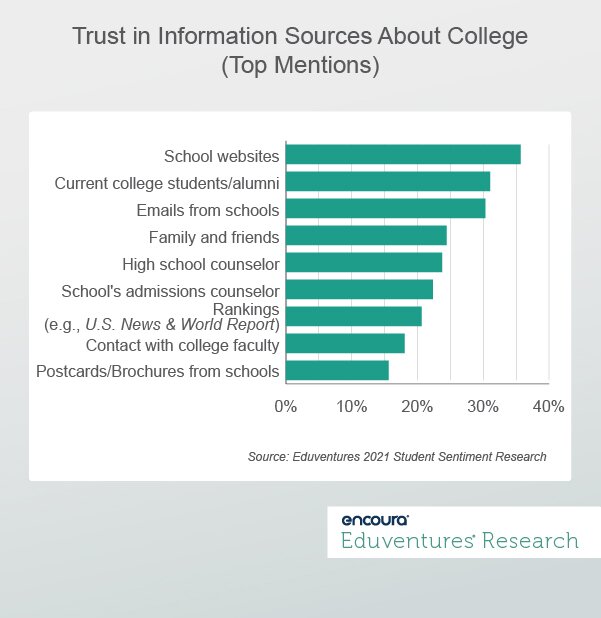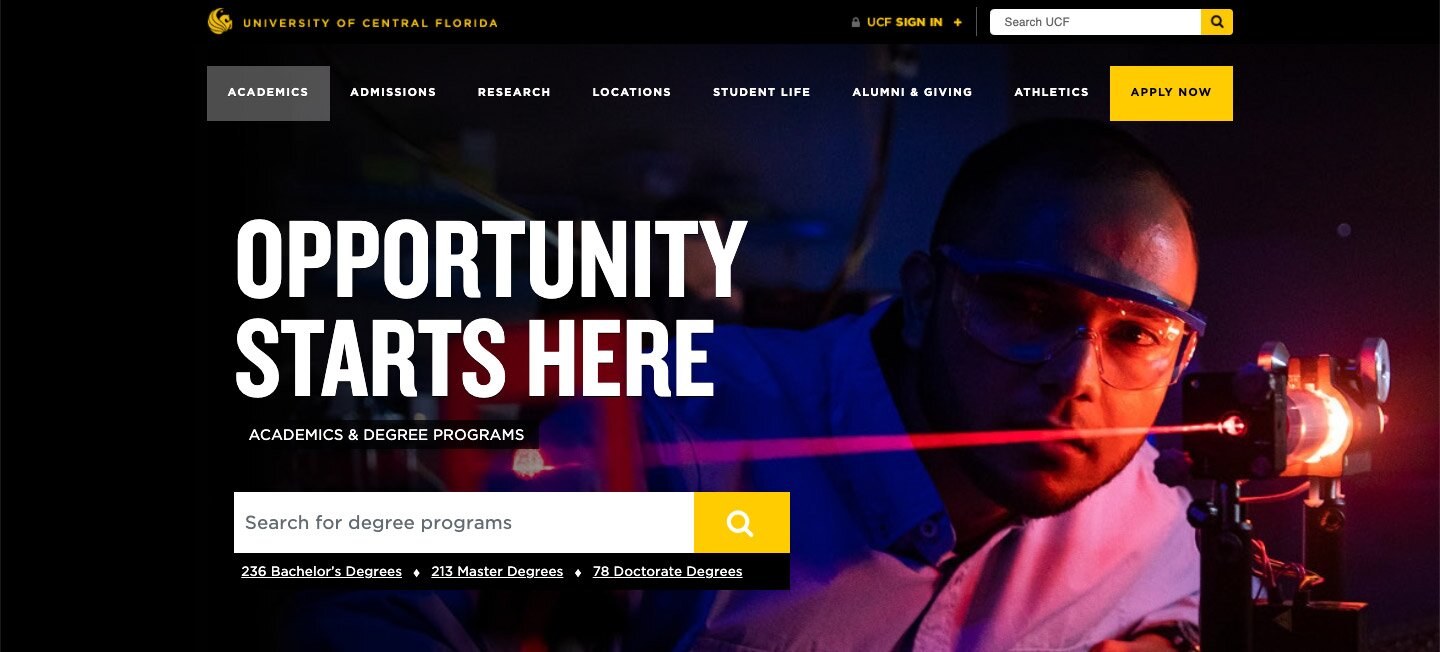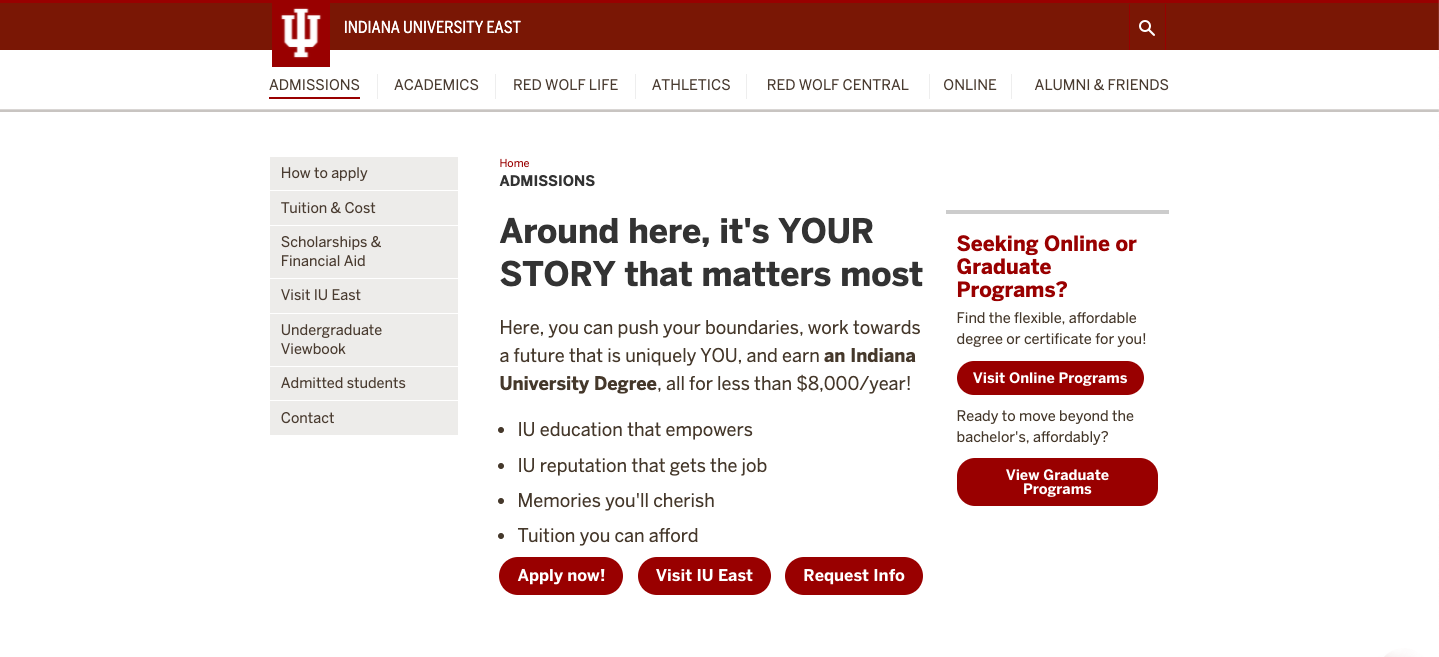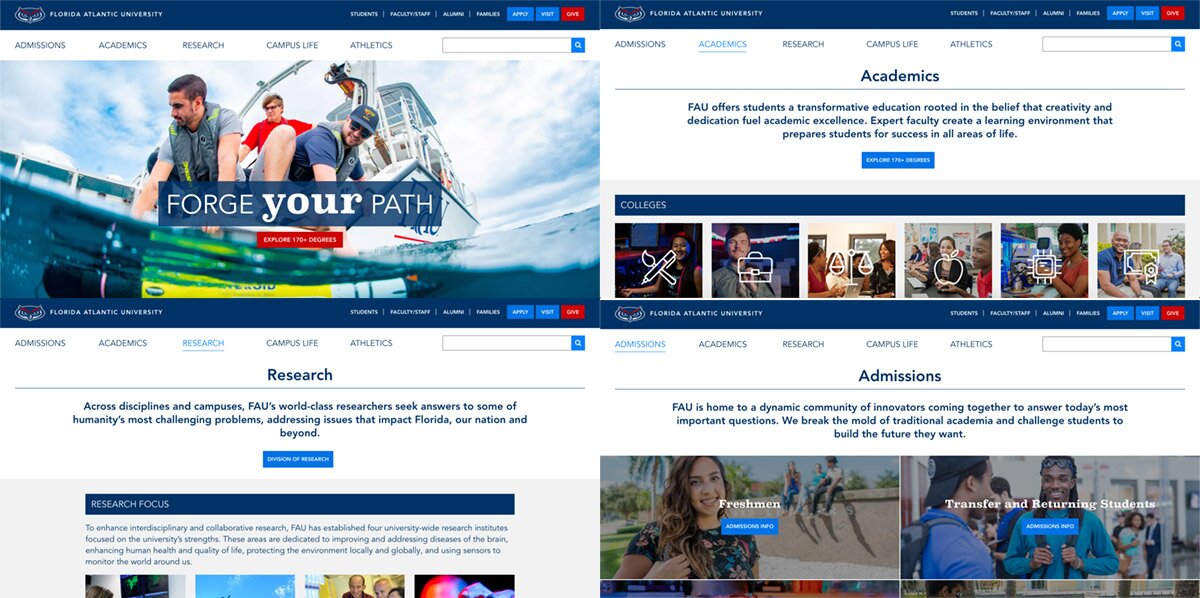How do prospective students learn about your institution? According to Eduventures’ research, nearly all college-bound high school students have explored a school’s website. And half of adult prospects interested in pursuing a master’s degree said they would use a school’s website – the most frequently mentioned information source – in college search.
It is no secret that your institutional website is one of your most important recruitment tools. Nonetheless, we commonly notice three mistakes that institutions make which could cost them the attention of their target audiences.
Here are three common mistakes to avoid.
From “Three and a Tree” to “Let’s Talk About ME”
Pandemic or not, the website has long emerged as one of the key recruitment tools according to college-bound high school students. Take, for instance, one of the questions we pose in our annual Student Sentiment Survey™: Which sources do you trust the most for information about colleges?
Figure 1 shows that high school students trust the information on your website more than they trust information from current students and alumni, family and friends, or even their high school counselors.

You can draw in a prospect's attention with a well-designed website as much as you can alienate with a boring or confusing site.
Fortunately, most institutions have long moved on from the clichéd “three and a tree” imagery—three students sitting gleefully under a tree on a manicured campus green—which graced many institutional homepages just a few years ago. Website imagery is now often more innovative than that. Still, many institutional websites could use some alterations to create more impact and draw greater student attention.
When Eduventures reviews institutional websites as part of our service offerings for higher ed partners, we often notice common mistakes schools make in their website designs. Here are three of them and some examples of how to do it better:
1. Telling instead of showing.
Humans react to visual cues. This is particularly true for Generation Z. Yet, many institutional websites feature too much text in the main content area or on subpages. Several paragraphs of densely written narrative that elaborate on your accomplished faculty or rigorous curriculum may be relevant to your institutional value proposition, but a reader's attention will stray after just a few sentences.
How to do it better: Break out dense narratives with the use of bullet points, sub headers, and widgets. Add statistics and other key facts and incorporate visual content such as pictures and video to tell your story.
Who does it well? The University of Central Florida’s website presents key information in bite-sized paragraphs, sub-content, bullet points, and statistics. Many pages include colorful pictures that tell the story in a more impactful way (Figure 2).

Source: https://www.ucf.edu/academics/
Other notable mentions include: University of South Carolina and Salem State University
2. Talking, not listening.
While it is important to use your website to communicate your institution’s many virtues, we find that some institutions spend little time addressing the very audiences they are trying to reach. Further, some don’t demonstrate a solid understanding of the types of students they attract and what matters to them. Just as anyone who gets bored listening to someone talk only about themselves, your students will lose interest if they don’t feel that you are connecting with them.
How to do it better: First, start by using “you” vs. “us” language. By that we mean, understand that your website is a communication tool, not just a reference guide, and address your prospects in this manner. Write “you’ll find your path among the 50 undergraduate majors we offer” instead of “we offer 50 undergraduate majors.” Next, think about the types of students who are interested in your institution and what matters most to them, and craft your message and story accordingly.
Who does it well? Indiana University East not only understands its cost conscious, outcomes-oriented audience very well, it also addresses its readers as if in a conversation (Figure 3).

Source: https://www.iue.edu/admissions/index.html
Other notable mentions include: Drake University and Hendrix College
3. Too many cooks, too many designs.
This mistake can be the hardest to rectify because it often stems from content ownership issues in the overall website design process. A well-designed website projects your institution’s unique image and viewers expect this image to be present across all subpages of your site. Sometimes, we come across a very different feel, tone, or design once we dig deeper into the sub-content of a website. This disrupts the flow of the experience and presents the institution in a disjointed, disconnected manner. This can occur during ongoing website updates, but often, it happens when website design responsibilities are split between several departments.
How to do it better: Assign website ownership to one dedicated office. Typically, this falls under the marketing department. It can be difficult to take autonomy away from other departments who were used to create content with little interference. But if they are still able to add to the core information while your design experts take care of layout, tone, and message delivery, everyone wins – especially your prospective students.
Who does it well? Florida Atlantic University designed its website to provide a holistic experience that feels authentic and unique. Every subpage has the same feel and look as the homepage, creating a cohesive presence (Figure 4).

Source: Florida Atlantic University homepage (fau.edu) and subpages
Other notable mentions: Baylor University and Michigan Technological University
The Bottom Line
Designing an effective website—one that is both eye-catching and covers a lot of content—is a complex task. To start, it helps to try to see your website experience through your target audience’s lens. Assign someone to navigate your institutional website and search for key information from the perspective of a student in the college search process. Ideally, this individual should not be involved in the design so that you get unbiased feedback.
Your Eduventures analysts are always happy to serve that role as part of your subscription with us. Interested? Please contact your Client Research Analyst for more information.
Never Miss Your Wake-Up Call
Learn more about our team of expert research analysts here.
Eduventures Senior Analyst at Encoura
Contact
The Program Strength Assessment (PSA) is a data-driven way for higher education leaders to objectively evaluate their programs against internal and external benchmarks. By leveraging the unparalleled data sets and deep expertise of Eduventures, we’re able to objectively identify where your program strengths intersect with traditional, adult, and graduate students’ values, so you can create a productive and distinctive program portfolio.
Over the past three years, Eduventures has developed a behaviorally and attitudinally-based market segmentation of college-bound high school students we call Student Mindsets™. This year, the sample of nearly 40,000 respondents was drawn from the myOptions® database of college-bound high school juniors and seniors as well as institutional inquiry lists, allowing us to refine and validate the Mindsets in a national sample of unprecedented breadth and depth.
These market “Mindsets” get at students’ imagined paths through college by assessing the desired outcomes of college, perceived importance of college experiences, and key decision criteria at time of application.
The fundamental purpose of the Eduventures Prospective Student Research is to help institutions better understand how college-bound high school students approach one of the most important decisions of their young lives. For a teenager, the college decision looms as a complex make-or-break moment, a pivotal turn on an imagined path to adulthood.

